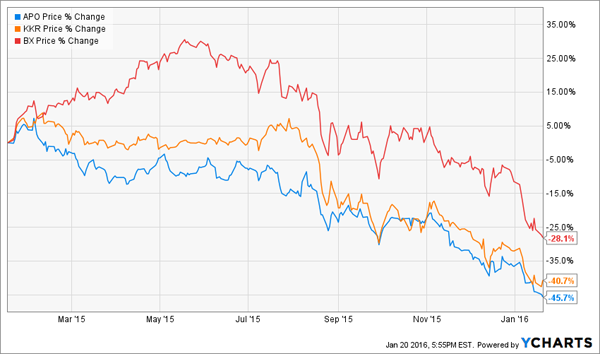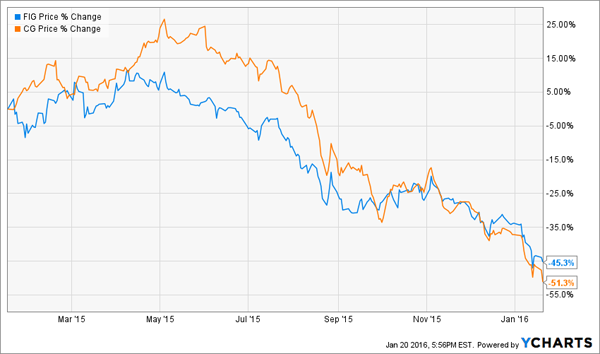This week oil crashed below $30 a barrel, the broader domestic indexes continued to pull back, and economies around the world – namely China’s – are growing riskier. There might be what some consider panic in the streets… but this isn’t entirely a buying opportunity.
After all, there are lots of dividend traps, falling knives and paper payout tigers ready to obliterate your value buying.
[ad#Google Adsense 336×280-IA]It pays to be cautious and careful right now. Especially for asset-price dependent firms.
Over the past few weeks I’ve been digging into some of the worst dividend payers whose shaky business earnings are putting their payouts at risk. These stocks look great on paper and have incredible – but unsustainable – payout yields.
In late December we dug into the falling knives of BDCs or business development companies that loan money to private firms. If the credit markets freeze up, these will be the first to go.
Two months ago I cautioned that Annaly Capital (NLY) and mortgage REITs (mREITs) should be sold immediately. As interest rates climb, the borrowing costs for these firms increase. Worse, their portfolio holdings are being devalued with every Fed interest rate hike.
Last week we showed how MLPs and oil could go lower than many are expecting. If it stays near $30 for a considerable time, it will throw a wet blanket on the plans of many MLPs and their optimistic earnings projections. If you own stocks like these, you should sell immediately.
A Warning Signal That Your Dividend is About to be Cut
Lots of stocks are getting haircuts during this pullback. Enthusiastic valuations and years of earnings increases have grown from financial monkeying – instead of real business growth. But now they’re starting to fade.
Now that money is getting expensive and the markets are pulling back, the industries that depend most on these conditions will deliver an unexpected return to investors, in the form of dividend cuts.
The most important factor to keep your eye on is the dividend payout ratio. It measures the percent of the net income that is distributed to shareholders as a dividend. Investors can use it to ensure a company is paying out a reasonable amount of its profits.
Once that ratio goes over 100% it’s not coming from earnings – you’re digging into assets, or taking on additional debt to fund the dividend. Few companies can keep that up for long.
It is this exact risk that brings me to my next group of paper payout tigers – the financial magicians from the asset management industry. Now, unlike most MLPs and overleveraged energy producers, I don’t expect any of these stocks will go under. They are well capitalized and seem to create money in ways no one ever dreams of.
Nonetheless, a pullback in the markets is hurting the bottom line. And very much like the MLPs, there are a number of asset management firms that may be forced to cut their dividends if their earnings don’t improve – fast. In fact, one already has.
For proof of how bad it could get, take a look at KKR & Co LP (KKR). It’s an investment firm that manages global investments across multiple asset classes, including private equity, energy, infrastructure, real estate, credit and hedge funds.
The company just slashed its payout from last year’s distribution policy. KKR is currently paying out a $0.64 annualized dividend that yields 4.5%. That’s less than half what the company paid investors over the previous twelve months. They, in turn, slashed the firm’s stock price – it’s down 40% over the last year.
Who’s next? These firms are likely to join KKR with lower payouts sooner rather than later.
Two Big Dividends Living on Borrowed Time
Blackstone Group LP (BX) is a global alternative asset manager. The firm focuses on investment vehicles like private equity, real estate, non-investment grade credit, secondary funds and exposures outside of other funds’ mandates.
The company is currently paying out a $1.96 dividend that yields 8%. With earnings of just $0.93 per share, this represents a dividend payout ratio of 152%. The stock is down over 43% in the past year.
Blackstone is another company with lumpy earnings and even bumpier dividend payouts. Because of the nature of their investments, their income isn’t as regular and consistent. It can be gloriously up one quarter and plunge the next. While viewing this on an annualized basis is best, it can still leave some holes.
Over the past few years BX has delivered notably higher first quarter dividend payouts than its fourth quarter. These asset managers pay out their dividends in the first quarters based off their internal expectations, and leave the last quarters based off the reality of their funds returns.
Like some of the other stocks here, the renewed interest in alternative assets as the markets crumble could help boost the bottom line. However, it’ll take time and the tough market environment may continue to make it difficult them to increase revenue – something BX hasn’t done in three quarters.
Apollo Global Management LLC (APO) is an investment manager in private equity, credit and real estate. The firm manages funds on behalf of pensions, sovereign wealth funds, institutions, and individual investors.
From a high of over $35 per share in 2014, the stock has been slowly rolling down a hill. At just over $13 now, it sits nearly 60% lower.
The company is currently paying out an annualized $1.40 dividend that yields 10.5%. It’s worth noting here that Apollo, like KKR previously, has a very uneven payout rate and that they frontload their dividends – traditionally the first and second quarters are the largest.
With diluted earnings of just $0.64 per share, this represents a dividend payout ratio of 371%. If the company can match last years earnings – something that might be challenging given our market environment today – it still won’t be enough.
Apollo has a lot of disparate investment segments, from retail joint ventures, global content providers, to international funds and even midstream gas deals. Its diversification could help the firm weather big changes… but it does expose it to unknown risks as well.
Asset Managers Get Crushed Ahead of, and During, Asset Price Selloff

And Two More Shaky Asset-Dependent Payouts
Two of the stronger members of the asset management group that didn’t make my first list but deserve a mention are Fortress Investment Group LLC (FIG) and The Carlyle Group LP (CG). These firms play in the same sandbox of high stakes asset management, financial alchemy and are in diverse range of markets and industries.
Fortress is yielding a seemingly sustainable 7.4% dividend while Carlyle is delivering a shakier 17.2% yield. The alarming part is that their dividend payout yields are 163% and 453% respectively.
Like their counterparts, these stocks have been cut in half – CG sits over 57% lower over the past year while FIG is down 49%. And like their counterparts, it seems only a matter of time before their dividends will need to be slashed.
Two Stock Splits, The “Unfortunate” Way

— Brett Owens
Safer Payouts – How to Secure Them [sponsor]
Eventually, asset prices will stabilize. Until that happens, I’m raking in much bigger – and safer – yields in another sector that’s capitalizing on the biggest demographic shift in U.S. history.
You see, no matter what happens to stock market, the outcome of this year’s election, or even China or the Fed, there’s one sure economic bet in America: The country will be older in the future than it is now and demand for healthcare services is set to skyrocket.
In fact, by 2024, national healthcare expenditures are expected to climb to $5.43 trillion, that’s about 20% of our GDP.
This growth is fueled in large part by the Baby Boom generation. They make up 28% of the U.S. population and number 77 million strong. 10,000 of them turn 65 every single day and will continue to do so every day for the next 15 years.
I’ve uncovered three particularly solid healthcare plays that are set to reap massive profits from this demographic shift.
They pay yields of 6.5%, 7.5%, and 8.2%, and all three are increasing earnings and their dividends annually. Click here for more details and to discover exactly how we’re profiting from the biggest demographic shift in U.S. history.
Source: Contrarian Outlook
